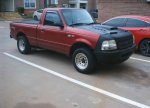cbxer55
Well-Known Member
- Joined
- Oct 9, 2009
- Messages
- 1,865
- Reaction score
- 767
- Points
- 113
- Location
- Midwest City, Oklahoma
- Vehicle Year
- 1998
- Make / Model
- Ford
- Engine Size
- 3.0
- Transmission
- Automatic
I have a 07 Mustang with the 4.0. I am not sure what model 4.0 it is though. It has 120,000+ miles and no rattle at all. I have no clue what oil the other owners use, but I am using Mobil One 10W-30 in it now. Also drive a 4.0 Ranger at work, not sure what year, but it is also very quiet.
My 3.0 Ranger with modified exhaust (no muffler, dual outlets in front of the tire) and cold air supplied cai with a JET chip on the computer, pulled a 2000+ pound trailer from CA to OK when I moved here in 02. It did excellent. Kept it in OD, except when pulling uphill. Ran 70, 76 and even 80 with that trailer behind it.
For those critical of the "bra", it's no longer there. I took it off recently, cleaned up the front end sufficiently that I threw the "bra" in the round-open-top file. I did keep the mesh part that covers the grill opening. It has attachments top and bottom, so I cut it off the main bra and tossed the rest. I like how clean my ac condenser is with no dead bugs or bird bodies in it. I am looking for a billet grill so I can delete the mesh as well. Found a billet grill at CARiD. It fits in the openings as an overlay, so the center parts don't have to be cut out, like some of the grills do.
My 3.0 Ranger with modified exhaust (no muffler, dual outlets in front of the tire) and cold air supplied cai with a JET chip on the computer, pulled a 2000+ pound trailer from CA to OK when I moved here in 02. It did excellent. Kept it in OD, except when pulling uphill. Ran 70, 76 and even 80 with that trailer behind it.
For those critical of the "bra", it's no longer there. I took it off recently, cleaned up the front end sufficiently that I threw the "bra" in the round-open-top file. I did keep the mesh part that covers the grill opening. It has attachments top and bottom, so I cut it off the main bra and tossed the rest. I like how clean my ac condenser is with no dead bugs or bird bodies in it. I am looking for a billet grill so I can delete the mesh as well. Found a billet grill at CARiD. It fits in the openings as an overlay, so the center parts don't have to be cut out, like some of the grills do.
Attachments
-
193.2 KB Views: 114


 . I am guessing I will get better reliability out of an 05 sohc than an 2000 ohv since all the rubber components and such will be failing on a 21 year old truck. Also, most all trucks that old are rusted to bits around here.
. I am guessing I will get better reliability out of an 05 sohc than an 2000 ohv since all the rubber components and such will be failing on a 21 year old truck. Also, most all trucks that old are rusted to bits around here. )
)













